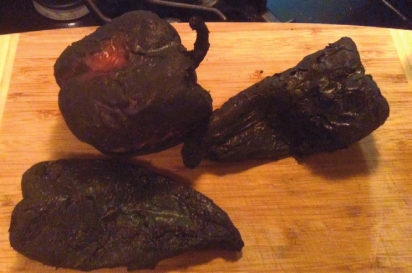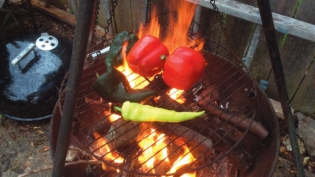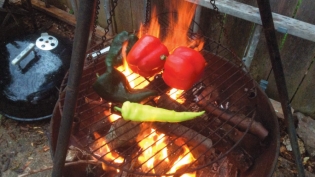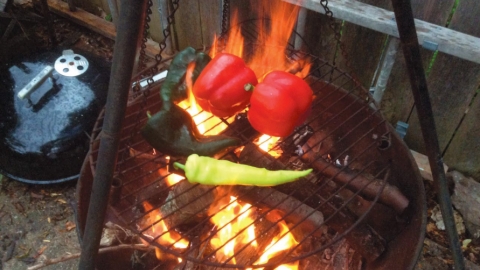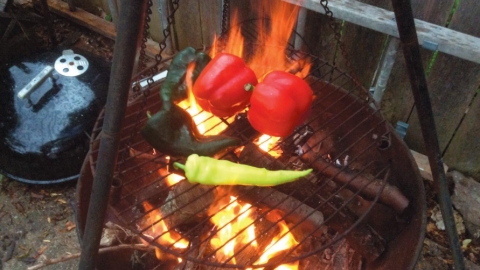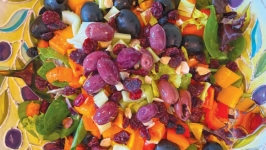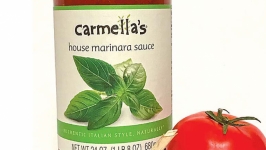Peel the Burn: Roasted Peppers
One of the best things about high-season at farmers markets is the availability of plain food at plain prices. At peak season, in fact, even gourmet veggies become affordable. Sweet red peppers, for example, which are piled in glossy heaps at Door County and Green Bay-area market stands in early autumn, can command $5 a pound at grocery stores during the rest of the year. But from now until the frost hits, you can get three or four peppers for just a buck.
Some vendors offer even better prices on larger amounts, or you can show up late in the day and find a seller who’s willing to bargain. When I come across a deal, I strike immediately, then plan a red pepper-roasting bonanza. Sun-soaked, fire-kissed and as brilliant as a maple tree in early October, roasted peppers add intense flavor and color to fall meals. They also freeze beautifully, extending one’s epicurean bargain into the expensive months ahead.
All sweet peppers can be roasted — green, yellow, orange, purple — but fully ripe, red ones have the sweetest, deepest flavor. Hot peppers, too — poblanos, banana peppers, jalapeños, etc. — become more tender and flavor-intensive when they’re charred.
Blackening peppers feels counter-intuitive at first, or like you’re getting away with a small crime. But you only need to blister the outer surface which imparts caramelized flavor as it loosens the skin from the inner flesh. The most toastiness comes from an open flame, especially one that rises from a wood fire. Still, a gas flame works just fine, either on the stovetop or under the broiler. Whatever your heat source, turn the peppers often and allow them to darken evenly all around.
When the peppers are blackened and have deflated, close them up inside a paper sack; steam produced within makes the skin easy to peel off with your fingers. Or you can rest them on a cutting board and lightly scrape off their skins with a sharp knife. (Don’t worry about getting every bit of char off the flesh; a little of it is delicious and distinguishes your hand-roasted beauties from peppers that come in jars from the store.)
Next, pull out the cores, scrape out the seeds and membranes, and cut peppers into sections. Load them into plastic cartons with tight-fitting lids (any liquid that has accumulated show go in, too). Then into the freezer they go.
Each week during the fall market season, I bring home a bagful of sweet reds and a selection of chilies. My husband, JB, and I also have been known to pick up a load of them at one of Door County’s many farm markets on our way to the family cabin on Washington Island. JB and I split the roasting duties during grill-out nights: he chars the peppers on a grate over the early, high flames of the fi re, then I do the peeling in the kitchen. We kill two birds with one stone: We feature roasted peppers in the evening’s dinner and also pack a few containers into the freezer.
Having roasted peppers on hand is like owning Italian leather shoes — they glamorize meals and accessorize a whole wardrobe of dishes. And anything a sweet or hot pepper can do, a roasted pepper can do better: provide an unctuous base for dips and spreads, accent salads and sandwiches, pump up soups and pastas, fill omelets and crepes. Puréed with olive oil, roasted red peppers make a glorious sauce that has any number of uses (see below). And it can be frozen, too.
8 USES FOR ROASTED RED PEPPER PURÉE
To make the puree, blend roasted red peppers (fresh or thawed) in a food processor or blender with 1 to 2 tablespoons olive oil for every pepper (and any flavorful liquid from the peppers themselves.) Then try any of these ideas:
- Sauté onions, garlic and cubed zucchini in olive oil. Stir in the purée and some chopped parsley or thyme. Heat through and toss with pasta.
- Whisk balsamic or sherry vinegar into the purée for a zesty salad dressing.
- Add 1/4 cup red pepper purée to water in which a cup of rice will be cooked. Gorgeous.
- Use it as a sauce for pizza.
- Replace mayonnaise with red pepper purée on a sandwich.
- Stir finely chopped toasted walnuts, crumbled feta cheese, red pepper flakes, ground cumin and lemon juice into the puree, to make a delicious dip. (Garlic would be grand in this mix, too.)
- Serve the purée as an accompaniment to roast meats, poultry, fish or vegetables.
- Thin the purée with a little water, then poach or bake eggs in it. Serve with toast for breakfast.



